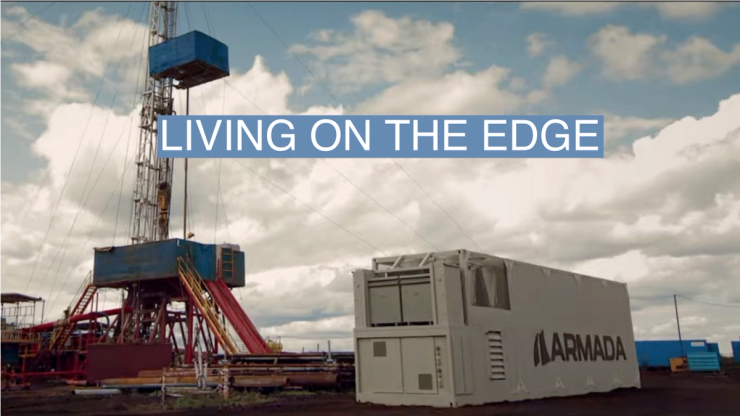The Scene
During a recent visit to an energy company’s oil rig, Dan Wright, CEO of AI-powered data platform Armada, was surprised to find the firm’s compute power located in what it called “the rig man’s house” — literally the home of a worker who operates the equipment.
The rig man’s ad hoc data center is one response to the treasure trove of data being produced in remote locations on the battlefield, in mines, and elsewhere. The problem has been where to process that valuable information, making it almost useless, and the latest AI advances have only exacerbated the problem.
Armada, a startup that emerged from stealth mode about a month ago, is trying to address that dilemma with mobile data centers, which can process information at the edge where it’s being generated. That can give a soldier an advantage in the middle of a firefight or help avoid a dangerous situation at a mine.
We talked to Wright about the future of warfare and emergency response in the edited conversation below.
The View From Dan Wright
Q: All of us are creating data all the time and it goes to this magical cloud somewhere and gets processed. Why is that not possible with the types of scenarios you work on?
A: A lot of these places are pretty remote. Think about an oil rig in the middle of the Gulf of Mexico, a mine in the middle of the Amazon. These places are outside of the cloud providers’ networks. There are no data centers anywhere nearby, and there’s a ton of data, terabytes per day. If you tried to process all that data in the cloud, latency would be a real problem. You can’t get to real time, you certainly can’t get to predictive analytics. The latency is a killer when it comes to making the data valuable, or decision making on the ground, which is what people want to do.
Secondly, the cost is prohibitive. So what happens is kind of crazy. Most companies are doing virtually nothing with this data today. People have always thought ‘the cloud is great,’ and we agree depending on what you’re trying to do. That worked really well when it was a centralized world where all the data is being generated in major metropolitan areas.
But not all of the data is going to the edge, the data is distributed. So you can’t have centralized infrastructure alone anymore. You also need some sort of distributed infrastructure to be able to process that data on the ground, and then you just send the metadata, or whatever data you want back to the cloud.
Q: So the metadata is why you need the Starlink connections?
A: People want to process data on the edge, but they want to do it as part of a unified system, where they see all of these different sites all over the world. They use the insights at the edge on the ground, but they also benefit from that on all their other sites all over the world.
Q: What are some real world scenarios?
A: Two weeks ago, I was at the White House with the CEOs of Anduril, the CTO of Palantir, Skydio, and others. We were meeting with top members of the National Security Council, talking about the situation in Ukraine and what’s going on in the world from a defense and intelligence standpoint. One thing that they really wanted to talk about is secure communications. Being able to use all of the data that people have at the edge — think on a battlefield — and generate insights and then communicate those to somebody else far away, in a secure way. You can actually create what’s called a mesh network.
The idea is that each — we call these modular data centers Galleons — can first serve as a node to a broader network that allows you to process data at the edge on the ground. And also, it’s got a local 5G, so you can interact with different drones, like Skydio does drones, or counter-drone technologies, like the ones that Anduril builds. It can communicate with those things to coordinate a response to what’s going on there.
Then you can take all of those insights, and you can communicate about them securely to another node, another location somewhere else. Another thing that was a big topic was de-mining. There’s a 75,000 square mile area of Ukraine that Russia has just peppered with mines. And if you have this mesh network, then you can actually use hyperspectral data to figure out where all those mines are.
Q: What’s hyperspectral?
A: It’s data that is given off from chemicals, where you’re able to detect it using even cameras. As an example, you could send out a bunch of drones over a large area and you can actually sense that there’s a change in color in the vegetation. You can tell by that whether there’s a mine. You can cover very broad areas and have all this data that could be used on the ground to make better decisions. But also, you could then send that data back to the Pentagon and coordinate a response.
Last week, I was with our team on an oil rig for a large oil and gas company in Oklahoma. They have hundreds of oil rigs and they have some compute already there. This particular one, they have a half rack of compute inside what they called the rig man’s house, a little house at the rig where this person lives 24/7 and operates the rig.
Then there’s a central command center, where there is an analytics team in Tulsa that talks to all the rig men or rig women in all of these different wells — and again hundreds of these rigs — and they help them to optimize the drilling process. If anything looks off, they call them and say, ‘you need to adjust the drill, you need to pay attention to this potential safety issue.’ They tell them if there’s some sort of thing that they’re concerned about that they need to change in terms of how they’re operating.
They have another rack as well as a small amount of GPUs on the rig. They know they need more compute, and they also know that they shouldn’t have it in the rig man’s house. It’s too hot, a fire hazard.
Q: Running it at the edge where the data is being generated is important because it would be too much to send to the cloud remotely?
A: In some of those use cases, especially in the DOD/intelligence area, security is also a big issue. You want to keep the data as much as possible on the ground, because the more it’s in motion, the more it can get hacked and it’s not secure. So only sending a smaller amount of data, and ideally, doing it via a secure connection is a better, safer way to do it. But the two primary things that come up in every conversation across all these different areas are latency and cost. You couldn’t do anything that’s real time or predictive unless you bring the compute to the edge. And even if you could, the cost would be a major barrier.
In the oil rigs example, there can be other issues, like they get tornadoes in Oklahoma. If they’re able to use all of that data to be alerted before anything that would cause a safety hazard or cause the rig to shut down., that’s very high value. The other thing that we see is if it can actually speed up the drilling process, or optimize that, or in the case of mining, speed up what they call the exploration process of figuring out where to mine, which today is a manual process that takes years. If you can speed those processes up, the ROI on that is through the roof. It enables you to find more areas to do this faster so your winning sites versus your competition. And secondly, you’re just getting more minerals out of the ground because you started sooner.
Q: Are the cloud companies your competition?
A: I actually think we’ll end up partnering with all the cloud providers. Here’s why: They all have their edge thing. However, those things have almost no deployments. The reason is that the services that people want to run at the edge do not work at the edge. Their edge thing means the edge of the cloud providers network. Our edge thing is more remote locations beyond the cloud providers network. So while you could buy hardware from them, you can’t actually get a cloud experience at the edge through them. In order to actually enable that, they would have to re-architecture the cloud, which they’re not going to do, because it’s way more expensive and because the incentives don’t make sense for them. They ultimately want to drive more to their current cloud architecture, and monetize that and compete against each other and acquire more market share there.
So we actually can be very complementary, where we help to take data that nothing has been done with today, process all that data locally in a way that actually solves a problem for a customer, and then still send data back to the cloud. So there are multiple ways we could partner.
Q: With all the advances in space and the growing number of satellites, will there be a time when the whole world is connected all the time and cloud networks span the globe?
A: It’s important to look at two different things. One is from a connectivity standpoint — absolutely. I don’t think it’s even an argument anymore. You look at what Starlink has done just over the last few years, from really not existing to now covering most of the globe, including the oceans. That’s only going to continue.
That is different from providing the rest of the stack. Because in order for the current cloud to provide the rest of the stack, they would have to build an entirely new architecture. I don’t think that is going to happen anytime soon. Or they would just have to build so many data centers that suddenly it covers the entire globe.
But nobody has figured out yet how to build a data center in the middle of the ocean, at least not at the size that they’re talking about. Rather than this centralized model where you’re talking about massive data centers, the faster way to get to what you’re saying, which is absolutely where the world is going, is a lot of small data centers.

Q: There’s probably a range of costs depending on what kind of compute you put inside of it, but what would the cost be generally?
A: Totally right. The way to think about a Galleon is it’s a set of SKUs. So it really depends on what you’re trying to do. If you want a version that you just wanted to run a single app on, that can be in the low hundreds of thousands, potentially. If you want one that is fully kitted out, that you can put six racks of compute and the latest GPUs on, and run a number of different cutting edge AI applications, it can be north of $1 million. So it really depends on what you’re looking to do.
The way that we’re approaching it is like the cloud provider. So we provide it as a service to customers. Then we also do all of the maintenance and if it needs to be moved around, which some of these do. These rigs move around often. The fact that these things are mobile is something that is helpful. But how we do it is based on a set of SKUs, depending on how much compute, how many GPUs. They also come with Starlink. If somebody wants to use another satellite ISP or a local 5G, it can have that in there as well.
Q: They come with Starlink, but you also said you’re doing mesh networking. Why use mesh versus Starlink?
A: What people want is a couple things. One is they want their internet to be always on and they want it to be optimized both for performance and for cost, and sometimes for security. The nice thing about a mesh is it allows you to have many different nodes, all of which can be redundant. In a combat scenario, let’s say one of these things gets blown up. You can send your data to another Galleon, and then you’ve still got your data.
The other thing is let’s say there’s some issue with Starlink. There’s a sandstorm or a weather issue that causes performance to degrade. We have an AI assistant that will alert you, ‘hey, there is a weather forecast that is likely to impact your Starlink performance at this specific site.’ Then you can switch over to an alternate form of connectivity. People also like to figure out how I can get the same connectivity for lower cost. That’s the benefit of a mesh network. You can optimize based on what you’re trying to do.
Q: You’re talking about the future of warfare and the fact that it’s going to be very AI heavy, very data heavy, so you’re going to need a lot of connectivity. You’re building the AWS for the battlefield, essentially.
A: The cool thing about it is that it’s mobile. The government is talking about stockpiling munitions. You need to think about stockpiling technology in the same way. You could have a bunch of these Galleons that are just ready to go where they’re needed. When they’re not needed, you move it to where they are.
This is a 40-foot Galleon. But we have a 20-foot Galleon. We’re developing that as we speak. That’s something that can be taken by a helicopter and dropped somewhere. It’s like a tactical command center. If you wanted to put it on a battlefield near all of those devices, the drones, then it can help process all the data from those sources. You can do AI at the site and figure out what’s the data that’s actually relevant for a given thing and then just send that data back. That’s a much more secure way to do it than sending everything back, and it’s more cost effective, too.
That’s also important for states for things like emergency response. Figuring out how can I stand up infrastructure very quickly so that if a tornado hits or if there’s a fire, I can bring these capabilities, and do things like bring hospitals and schools back online very quickly.


